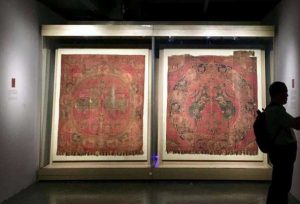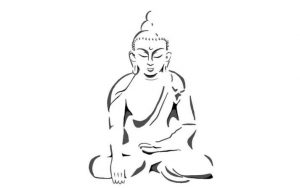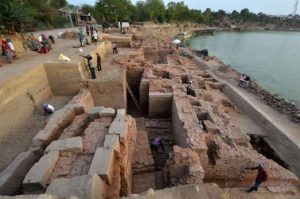This is Part Two of a look at how Dharma Bum Temple in San Diego brings the Dharma to local residents and students in an American context of meaning-seeking and meditation. Rather than Americans “becoming Buddhist,” how is Buddhism “becoming American?” Click here for Part One.
How the Dharma Bum Temple adapts and transforms

Through deeper analysis of the perspectives with which Western people often come into Buddhist spaces, the main difficulty with the integration of Buddhism into Western society and culture becomes clear. There is a significant difference between knowing and implementing Buddhist practice within our lives; Western people tend to struggle with the application aspect! The simple solution to this problem would simply be not to take it on and to leave Buddhist practice to those whose conditioning it aligns with. This would make it pretty inaccessible to a significant portion of the population in the West. Nonetheless, leaders such as those of the Dharma Bum Temple (DBT) have chosen to take on the challenge of navigating these cultural and theoretical differences in order to introduce Westerners to the Buddha’s teachings.
In helping people to overcome their tendency to overcomplicate the teachings, co-founder Jeffrey Zlotnik often reminds visitors that the Buddha instructed all of his disciples to apply his teachings in their lives through action, and then evaluate whether they are beneficial to them. It is more likely for practitioners to gain a deeper understanding of the teachings by practicing rather than thinking about them; from there, people can more easily decide whether or not the practice works for them and then move forward accordingly. As Zlotnik emphasizes with the DBT community, there is absolutely no shame in trying!
In his lifetime, the Buddha himself utilized a form of guidance known as upaya, which means the skillful adaptation of teaching methods depending on specific audiences. When sharing his teachings with disciples, the Buddha skilfully adapted his teachings so that they connected with each local culture. He believed that understanding the Dharma was far more valuable than the means by which people come to learn it in the first place. The DBT utilizes upaya in the hope of connecting with Western lifestyles, transforming perspectives, and ultimately guiding people down a path toward awakening.
Leaders at the DBT have been creating ways to overcome Western barriers for 17 years, and a variety of specific practices have prevailed as a result. One of the main teachings that the temple utilizes and teaches in introducing new Western practitioners to Buddhism is the middle path. The DBT operates in ways that avoid extremes and focus on ethical practices. The first way that this is done is through finding a balance between cultural and pedagogic practices. As mentioned earlier, DBT classes refrain from ritualistic practices such as bowing and chanting in order to decrease the amount of unfamiliarity for new practitioners. Nonetheless, leaders make sure that people still get to see and acknowledge the importance of those factors in many cultures. When entering the meditation hall, practitioners must remove their shoes, and in the hall they will find a traditional shrine. Leaders often make offerings to the Buddhas, recite the Triple Gem, and close their practice with a transfer of merit. Nonetheless, guests are not expected nor pressured to participate in these things, and are welcome to do only what they are comfortable with.
When somebody is well integrated into the DBT sangha, they often begin to embrace cultural practices at their own pace. The temple aids in this process in a variety of ways. For one, the DBT community often visits and goes on retreats to other temples and monasteries of differing traditions. Some examples are Metta Forest Monastery, Hidden Valley Zen Center, Pao Fa Temple, Hsi-Fang Temple, Deer Park Monastery, and Drikung Kyobpa Choling.
Temple organizers also bring in speakers, such as Venerable Robina Courtin, Ven. Pomnyun Sunim, Anam Thubten, and Thanissaro Bhikkhu (Ajahn Geoff), who have all shared significant wisdom as well as some cultural insights with the DBT Sangha. Apart from hosting speakers, the DBT sangha also plans visits to other temples and monasteries of different Buddhist traditions. Although DBT doesn’t follow a specific tradition, they deeply respect and acknowledge all of those that come from all over the world. Once Buddhism is introduced to people within the realm of the local Western culture, their minds and hearts may become more open to the more cultural and traditional aspects of the practice.

Zlotnik credits Japanese Zen monk Shunryu Suzuki as an inspiration for the way in which they have set up the DBT. Suzuki built the San Francisco Zen Center in a diligent and courageous way. At the time, he faced harsh criticism from the Japanese community, who felt that he was turning his back on them. In reality, he felt that he needed to adjust his means of teaching in order to introduce Buddhism to the people of San Francisco. In his writings, Suzuki likened building Buddhism within a new culture to that of expecting a flower to bloom from a rock. Much like leaders at the DBT, he recognized the importance of meeting local people where they were in order to initially make the teachings more accessible.
Additionally, Zlotnik has made sure that practitioners are centering self-realization in their practice rather than belief. The practice is about holding up a mirror to one’s own wrongdoings, struggles, ego, and self. While this reality is made extremely clear to visitors, leaders are very intentional about when they will correct the actions of their visitors. When it comes to practices such as physically sitting in meditation, temple leaders gently guide with regard to posture, but are very careful about when and how they correct guests as it is important that people don’t feel that leaders are critiquing them. There is a balance between exposing the raw truths about Dharma practice to people while also granting them the space to explore what works best for them in incorporating the practice that the DBT is committed to upholding.
It is also important to acknowledge that practitioners can absolutely abide in the sensation of breathing in order to settle their minds, but then they must be willing to open the wounds of the pain and harm that they have caused themselves and others, and to examine them. In order to inspire people to abide in and explore their suffering, the DBT utilizes a practice of the Six Paramitas that guides people toward a better understanding of what Buddhism is. While leadership at the DBT makes sure to show people that the practice is not an escape, and that it is not always joyful, they also emphasize the fact that this should be a liberating rather than terrifying realization. Through the practice of the paramitas, the temple adapts to Western worldviews in an attempt to eventually and ultimately reshape them.
The temple begins this process by utilizing the practice of generosity. The temple is generous with its community by offering all programs and classes free of charge. There are no fees or dues required in order to participate in any temple activities, as they do not want to impose any additional barriers on practitioners who are simply trying to show up, learn, and better themselves. Additionally, there are a variety of programs hosted by the temple, such as homeless and prison outreach, that give the community opportunities to put their own suffering in perspective by serving those in need. Additionally, these community-service opportunities ensure that teachings that are spoken about in classes, for example that compassion and generosity are followed up by action and are not just understood as intellectual concepts!

Temple leadership practices morality by being honest about the fact that those who lead are not nuns, monks, gurus, or teachers. Rather, they are all lay practitioners sharing their own interpretations of the Dharma. This differs from many cultural temples that have head nuns or monks who regularly lead. The fact that the DBT is a peer-led community tends to help remove barriers that at times make Western people feel uncomfortable at cultural temples. There is no “us and them,” as every leader is honest about where they are in their practice. Nonetheless, leaders practice the middle path in their roles by maintaining boundaries with the community despite presenting themselves as one of them. In doing so, there is a healthy balance of respect and connection between guests and leaders that is difficult to find elsewhere.
The DBT also operates from a place of attentiveness and diligence. Not only do leaders work hard at building and maintaining the actual physical space, they are diligent in their process of learning and understanding what works and what doesn’t work within the community. There is much diligence in the understanding that leaders are also growing and learning new things everyday, and it is necessary to adapt to individual peoples’ needs. Although there are aspects of Western culture that shape general, common misunderstandings about Buddhism when Americans first enter these spaces, there also must be a constant awareness of individual differences between people, as it is unproductive to assume and expect the same from everybody.
Some types of people that temple leadership have noticed are: the intellectuals, who are more Dharma-driven; and the sangha-driven practitioners, whose interpretation of the Dharma is often tied to intense emotion. Countless people are somewhere in between, and many others just happened to stumble into the DBT one day with no expectations at all. Nonetheless, all of these characteristics have brought people to the temple, serving as gateways into the Dharma. Each one must be acknowledged and appreciated, and it is important to recognize where each individual is in order to continue to guide them toward the Dharma.
In Zen Mind, Beginner’s Mind, Suzuki-roshi shares his teachings on the beginner’s mind, which is a state of perception that possesses endless potential when provided with proper resources. With open and curious minds, new practitioners are not resistant to the Dharma. For this reason, Roshi taught that even a well-instructed disciple of the Buddha’s teachings should try to maintain this beginner’s mindset, as it is what allows for the greatest amount of insight and deep understanding, devoid of expectations. In an attempt to foster the beginner’s mind, the DBT offers patience to each member of our community, as almost everyone who first enters this space knows little to nothing about Buddhism. Through utilizing the middle path and the practice of the paramitas, leaders gently correct peoples’ misconceptions without judgment.

Those leading new practitioners at DBT also deeply understand that the Buddhist practice cultivated in this space has to come from the foundation of a meditative place, which exemplifies the temple’s practice of another paramita, concentration. Although meditation is not always easy, community members are empowered to keep practicing in order to cultivate a deep meditation practice, because, ultimately, settled minds are more able to share the teachings and be of service to the community.
Comprehensively, there was immense wisdom involved in the creation of the DBT, and leaders must continue to act wisely in preserving it. There is wisdom in the application of the first five paramitas as well as the understanding that leaders’ views and the community will always be changing and evolving. There is an understanding that programs will change in order to operate in ways that best serve the community based on so many different factors. By applying a thoughtful practice of the paramitas to DBT operations, the DBT and those who lead are given the valuable opportunity to hold space for Westerners to stumble in with no knowledge, and to ultimately find a place that they can call their spiritual home.
The temple truly faces a delicate task in remaining in an American context while reshaping Americans’ expectations of what Buddhism is: it is, at its core, the Buddha’s path of liberation from suffering, which is completely different to what we typically understand as “escaping” or “distracting” from our existential conundrums; to engage with not only suffering but how the mind is our generator of and liberator from suffering. Much like Suzuki-Roshi once shared, we cannot expect a flower to blossom from a bare rock. For Buddhism to take root in a new culture, it must be diligently and patiently fostered. This is DBT’s multi-layered challenge, and they are honored to take it on!
Related features from BDG
Skillfully Bringing Buddhism to the West: San Diego’s Dharma Bum Temple, Part One
Delta Beta Tau at San Diego State University: The Nation’s First Buddhist Fraternity












